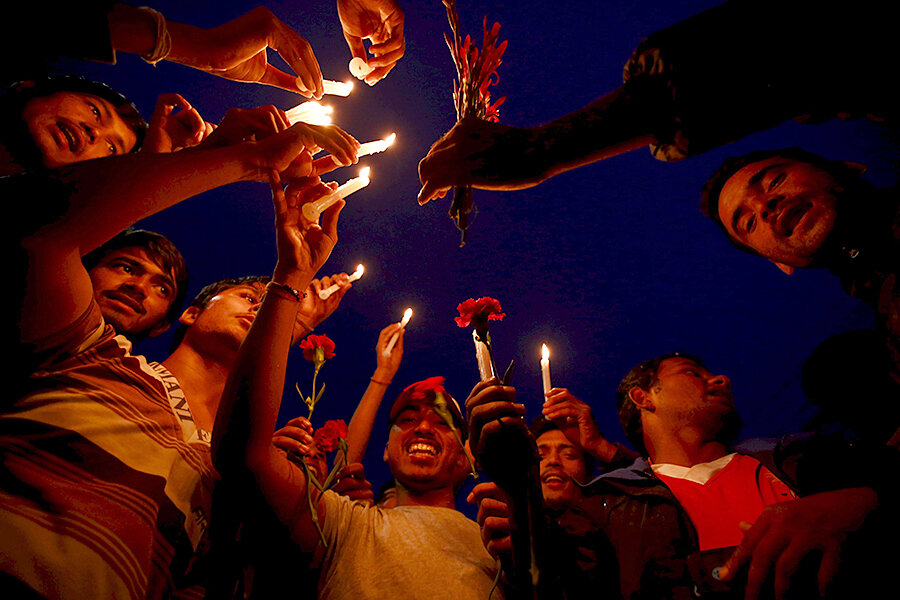Nepal approves new constitution but secessionist threat lurks in south
| Kathmandu, Nepal
By a landslide vote, Nepalese lawmakers ratified a new federal constitution here Wednesday, fulfilling a decade-long dream.
A modern governing charter had eluded Nepal during years of violence and bickering. But a series of devastating earthquakes in April and May – and public demand for rebuilding – has spurred a rare unity between the ruling coalition and the Maoist opposition party.
The constitution, the first since Nepal became a republic, took seven years to draft and passed by a whopping 507 to 25 vote yesterday evening.
President Ram Baran Yadav is expected to formally issue the document Sunday, capping a peace process between the government and Maoist rebels who fought for 10 years, until 2006, leaving more than 17,000 dead.
“The approval of the people’s constitution by the constituent assembly is a matter of pride for all Nepalis,” Prime Minister Sushil Koirala said.
Yet in an early sign of trouble, a number of regional parties, mainly in Nepal's southern belt along the Indian border, have rejected the constitution and its formula of seven states under a federal government.
For the past month they have staged violent protests in the flatlands of Madhes, objecting to the new constitution's configuration of state borders in their area. The protests have left at least 43 dead, including 11 security personnel, and have severely disrupted trucks ferrying supplies from India to Kathmandu.
Regional leaders in Madhes say that lawmakers in Kathmandu have drawn the borders of their region in a way that will keep their ethnic groups weak and divided.
Secessionist undertones?
Upendra Yadav, chairman of Federal Socialist Forum Nepal, the biggest party in Madhes leading the protests, wants the 22 districts in Madhes partitioned into one or two Madhes states.
“Mixing districts in Madhes with hill and mountain districts will continue to keep Madhesis as minorities,” Mr. Yadav says.
The most recent demonstrations in Madhes have had secessionist undertones. Madhesi leaders such as Sadbhavana Party Chairman Rajendra Mahato have voiced threats to break away, which has soured national opinion on their demands. Maoist chairman and former premier Prachanda, who goes by one name, has termed secessionist talks as “suicidal and treasonous.”
Analysts offer contrasting opinions on the constitution and the challenges it faces.
“This constitution will have a very short life, the shortest of all constitutions we had,” says Yubaraj Ghimire, editor-in-chief of Annapurna Post daily. Mr. Ghimire argues that too few people, and mostly elites, played decisive roles in passing the document and that it is not ready. “It’s an inadequate constitution. It might possibly trigger further conflict,” he adds.
Gunaraj Luintel, editor-in-chief of Nagarik daily in Kathmandu, is more optimistic. “Nepal has been in a mess for too long. Promulgation of the constitution is urgent,” he says, arguing that problems can be met through amendments. “Writing a constitution through an assembly elected by the people specifically for the purpose is as democratic as it gets, Mr. Luintel says. “There isn’t a better way to write a constitution.”
The territory known as Madhes stretches widely from east to west. Its population is largely Madhesis and Tharus ethnic groups, and its vast swaths of arable land serve as the landlocked country’s food bowl. It's also a chokepoint for imports from India of daily essentials, everything from kerosene to ketchup.
Madhesis are not a single ethnic group: They consist of many ethnicities residing in Madhes and include a sizeable population of migrants.
Raj Kumar Lekhi, a leader of the biggest ethnic group in Madhes – the Tharu – also rejected the constitution. With population of over 1.7 million, Tharu is the fourth largest ethnic group in Nepal.
125 castes and ethnicities
“Two provinces in Madhes – one for Tharu and one for Madhesi – will meet the demands of both Tharus and Madhesis,” Lekhi said in a phone conversation with the Monitor.
Worries are being expressed that assigning specific provinces to specific ethnic or social groups – the main idea being floated in Madhes – could trigger an unending fragmentation or Balkanization of a country with some 125 castes and ethnicities.
Under the new constitution Nepal's seven states will have elected governments and parliaments. There will be a bicameral parliament at the center, a parliamentary system of democracy and a ceremonial president.





